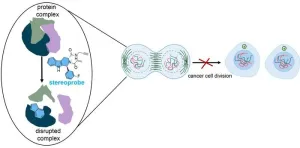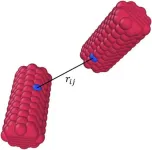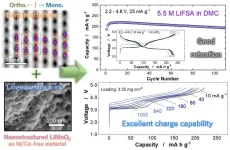(Press-News.org) Embargoed for release until 5:00 p.m. ET on 26 August 2024
Annals of Internal Medicine Tip Sheet
@Annalsofim
Below please find summaries of new articles that will be published in the next issue of Annals of Internal Medicine. The summaries are not intended to substitute for the full articles as a source of information. This information is under strict embargo and by taking it into possession, media representatives are committing to the terms of the embargo not only on their own behalf, but also on behalf of the organization they represent.
----------------------------
1. High BMI eligibility for semaglutide could cost Medicare an additional $145 billion annually
Abstract: https://www.acpjournals.org/doi/10.7326/ANNALS-24-00308
URL goes live when the embargo lifts
A brief research report found that 61% of Medicare-eligible adults have a BMI of 27 or higher, which means they may benefit from a GLP-1 receptor agonist like semaglutide for weight loss. However, the number of patients who will be eligible for semaglutide under new Medicare Part D plan guidelines that require patients to also have established cardiovascular disease will vary depending on how cardiovascular disease (CVD) is defined. When established cardiovascular disease is narrowly defined, only 1 in 7 Medicare beneficiaries with elevated BMI would likely be eligible to receive semaglutide, adding a maximum annual costs of $34 billion in additional drug spending. However, if any beneficiary with elevated cardiovascular risk was to become eligible for semaglutide, Medicare could face additional annual costs of up to $145 billion. The findings are published in Annals of Internal Medicine.
Researchers from Brigham and Women’s Hospital, Harvard Medical School, and Northwestern University examined NHANES (National Health and Nutrition Examination Survey) between 2011 and 2020 to the Medicare beneficiaries who are most likely to be newly eligible for semaglutide based on SELECT trial criteria. They also describe which beneficiaries had any increased risk for future cardiac events and could be eligible pending future evidence generation and Part D coverage decisions. The researchers then estimated the maximum cost to Medicare Part D that would arise from providing coverage to these various groups of patients by multiplying the number of newly eligible Medicare beneficiaries by the annual net price of semaglutide, generated by subtracting a 41% average discount from the manufacturer list price of the medication in March 2024. The data showed that approximately 61% of Medicare-eligible adults with complete data had obesity and would potentially benefit from semaglutide for its weight loss benefits. However, when established cardiovascular disease is defined narrowly as in the SELECT trial, only 1 in 7, or 3.6 million people, would be likely to be newly eligible for semaglutide. Alternatively, if a more liberal definition of established CVD risk were used by Part D plans, then 15.2 million people would be eligible. Even in the most likely scenario where conservative definitions of CVD are used and many people do not stay on semaglutide long-term, Medicare spending could increase by $10 billion annually. The authors note that the analysis estimates maximum budgetary impacts but is not a spending projection and does not account for future payment reforms via the Inflation Reduction Act.
Media contacts: For an embargoed PDF, please contact Angela Collom at acollom@acponline.org. To speak with corresponding author, Alexander Chaitoff, please e-mail amchait@med.umich.edu.
----------------------------
2. Yoga no more effective than general exercise in reducing urinary incontinence in older women
Abstract: https://www.acpjournals.org/doi/10.7326/M23-3051
URL goes live when the embargo lifts
A randomized trial involving middle aged and older women reporting daily urinary incontinence (UI) found that a pelvic floor yoga intervention did not result in a greater improvement in UI symptoms compared to a general muscle stretching and strengthening exercise program. However, participants in both intervention groups reported some improvement in their UI symptoms. These findings are important because 1 in 3 women in this age group experience UI, which can lead to depression, social isolation, and functional decline. The study is published in Annals of Internal Medicine.
Yoga has been recommended for women with UI, but there is little data available to determine its efficacy. Researchers from the University of California San Francisco randomly assigned 240 women aged 45 years or older reporting daily urgency-, stress-, or mixed-type UI to either 12 weeks of a yoga or a nonspecific stretching and strengthening exercise program to compare the two interventions for improving symptoms of UI. Women in the yoga group had twice-weekly group instruction and once-weekly self-directed practice of pelvic floor–specific Hatha yoga techniques, while the exercise group had equivalent-time instruction and practice of general skeletal muscle stretching and strengthening exercises. Participants used a diary to record each time they leaked urine by frequency and type of UI at baseline, 6 weeks, and 12 weeks and were also asked to complete and return diaries after 24 and 36 weeks for assessment of persistent changes in UI. The researchers found that the yoga intervention was not superior to the general exercise program in reducing clinically important UI and both groups had similar incidents of adverse events. According to the researchers, future studies should investigate potential effects of yoga on type-specific UI and factors underlying perceived improvements in UI among older women engaged in yoga and other physical interventions.
Media contacts: For an embargoed PDF, please contact Angela Collom at acollom@acponline.org. To speak with corresponding author, Alison Huang, MD, MAS, please email Elizabeth Fernandez at Elizabeth.Fernandez@ucsf.edu.
----------------------------
3. Dementia risk similar with SGLT2 inhibitors and dulaglutide
Abstract: https://www.acpjournals.org/doi/10.7326/M23-3220
URL goes live when the embargo lifts
A nation-wide, population-based cohort study compared the effects of sodium-glucose cotransporter-2 (SGLT2) inhibitors versus dulaglutide on risk for dementia in older patients with type 2 diabetes (T2D). The data revealed little difference in the risk for dementia for SGLT2 inhibitors compared with dulaglutide. The study is published in Annals of Internal Medicine.
Researchers from the Sungkyunkwan University (SKKU) of South Korea studied data from over 13,000 adults from the National Health Information Database in South Korea to evaluate the effect of treatment strategies on risk of dementia. The eligibility criteria were selective, with participant requirements including being age 60 years or older, having a T2D diagnosis, no history of dementia, and no use of antidiabetic drugs for the three months preceding the study. Through these requirements, researchers aimed to improve the probability that participants in both treatment groups were at a similar disease stage. Researchers assigned participants to an SGLT2 inhibitor or dulaglutide, and to directly compare the effects of each treatment, they matched each patient receiving SGLT2 inhibitor with another patient receiving dulaglutide whose propensity score is closest to their own. For each patient, follow-up started at treatment assignment and ended at dementia onset, death, or 31 December 2022, whichever occurred first.
Final data showed a risk for dementia between 2.5 percentage points lower and 0.6 percentage point greater for SGLT2 inhibitor than for dulaglutide, suggesting no statistically significant difference in dementia risk between the drugs. The study is novel in directly comparing the risk for dementia between the two novel antidiabetic agents, recently added to the researchers’ recommendations. These findings contribute to a library of previous studies that have suggested that both SGLT2 inhibitors and GLP-1 RAs, such as dulaglutide, may have potential neuroprotective effects.
Media contacts: For an embargoed PDF, please contact Angela Collom at acollom@acponline.org. To speak with corresponding author Ju-Young Shin, PhD, please email shin.jy@skku.edu.
----------------------------
4. EUS-RV and precut sphincterotomy equally effective salvage techniques to treat benign biliary obstructions and can serve as a backup for each other
Abstract: https://www.acpjournals.org/doi/10.7326/M24-0092
URL goes live when the embargo lifts
A randomized control trial compared endoscopic ultrasound-guided rendezvous technique (EUS-RV) and precut sphincterotomy as salvage techniques for difficult bile duct cannulation in benign biliary obstruction. The data revealed EUS-RV and precut sphincterotomy have similar success rates, and in failure of one technique, the other technique was successful. The study is published in Annals of Internal Medicine.
Researchers from the Postgraduate Institute of Medical Education and Research in Chandigarh, India, studied data from 100 adult patients with benign biliary disease and difficult bile duct cannulation requiring salvage strategy. Participants were selected if they were older than 18 years, have benign cause of extrahepatic biliary obstruction with native papilla, and experienced difficult bile duct cannulation at the index endoscopic retrograde cholangiopancreatography (ERCP) attempt. Researchers randomly assigned participants to either precut sphincterotomy or EUS-RV, although the participants were blind to the technique. 2 experienced endoscopists well-versed in both techniques performed the procedures. In the case of failed precut sphincterotomies, patients were crossed over to EUS-RV and vice versa. The technical success was defined as successful deep biliary cannulation confirmed on cholangiogram using either of the 2 techniques and compared using the Fisher exact test. Researchers found that both EUS-RV and precut sphincterotomy showed similar technical success, procedure time, and adverse events profile. Notably, in the failure of one technique, crossover to the other technique helped to achieve successful cannulation in all cases. This study is the first randomized control trial that has compared these salvage methods for difficult bile duct cannulation, and it adds to the currently limited data on biliary access for benign diseases.
Media contacts: For an embargoed PDF, please contact Angela Collom at acollom@acponline.org. To speak with corresponding author Jayanta Samanta, MD, DM, please email dj_samanta@yahoo.co.in.
----------------------------
END
High BMI eligibility for semaglutide could cost Medicare an additional $145 billion annually
2024-08-26
ELSE PRESS RELEASES FROM THIS DATE:
Brigham-led study estimates 1 in 7 Medicare beneficiaries with high body mass index may qualify for anti-obesity drug
2024-08-26
If Medicare Part D narrowly defines cardiovascular disease, majority of patients would remain ineligible while new federal spending could still exceed $10 billion
Current federal regulation restricts Medicare from covering drugs prescribed solely for weight loss. However, in March 2024, Medicare announced it would extend coverage to semaglutide (Wegovy), a popular glucagon-like peptide-1 receptor agonist (GLP-1RA), for patients with elevated body mass index (BMI) who also had established cardiovascular disease (CVD). This means that the definition of “established CVD,” which has not been ...
$66 million in 10 years: Groundbreaking strategic investment fund to drive biomedical innovation in Australia
2024-08-26
With a grand vision of investing $66 million over 10 years in groundbreaking medical innovations, WEHI’s first strategic investment fund, 66ten, is the largest internal pre-seed and seed fund created by an Australian medical research institute.
Managed by WEHI Ventures, 66ten serves the sole purpose of bridging the gap between scientific discoveries and commercial viability, ultimately creating both positive outcomes for patients and healthcare systems globally as well as financial returns to investors.
Since its foundation a year ago, 66ten has ...
New way to potentially slow cancer growth
2024-08-26
LA JOLLA, CA—Fighting cancer effectively often involves stopping cancer cells from multiplying, which requires understanding proteins that the cells rely on to survive. Protein profiling plays a critical role in this process by helping researchers identify proteins—and their specific parts—that future drugs should target. But when used on their own, past approaches haven’t been detailed enough to spotlight all potential protein targets, leading to some being missed.
Now, by combining two methods of protein analysis, a team of chemists at Scripps Research has mapped more than 300 small molecule-reactive ...
Using machine learning to speed up simulations of irregularly shaped particles
2024-08-26
Simulating particles is a relatively simple task when those particles are spherical. In the real world, however, most particles are not perfect spheres but take on irregular and varying shapes and sizes. Simulating these particles becomes a much more challenging and time-consuming task.
The ability to simulate particles is critical to understanding how they behave. For example, microplastics are a new form of pollution as plastic waste has increased drastically and uncontrollably decays in the environment ...
Ochsner Digital Medicine teams up with AmeriHealth Caritas Louisiana to improve treatment of hypertension, Type 2 diabetes
2024-08-26
New Orleans, LA. – Ochsner Digital Medicine has teamed up with AmeriHealth Caritas Louisiana to offer digital medicine services to the health plan’s members. Utilizing remote patient management (RPM), Ochsner Digital Medicine and AmeriHealth Caritas Louisiana will work together to help members with certain chronic conditions better manage their health and improve their quality of life.
AmeriHealth Caritas Louisiana, part of the AmeriHealth Caritas Family of Companies, is a Healthy Louisiana managed Medicaid health plan covering ...
Closing the RNA loop holds promise for more stable, effective RNA therapies
2024-08-26
New methods to shape RNA molecules into circles could lead to more effective and long-lasting therapies, shows a study by researchers at the University of California San Diego. The advance holds promise for a range of diseases, offering a more enduring alternative to existing RNA therapies, which often suffer from short-lived effectiveness in the body.
The work was published Aug. 26 in Nature Biomedical Engineering.
RNA molecules have emerged as powerful tools in modern medicine. They can silence ...
Controlling molecular electronics with rigid, ladder-like molecules
2024-08-26
As electronic devices continue to get smaller and smaller, physical size limitations are beginning to disrupt the trend of doubling transistor density on silicon-based microchips approximately every two years according to Moore’s law. Molecular electronics—the use of single molecules as the building blocks for electronic components—offers a potential pathway for the continued miniaturization of small-scale electronic devices. Devices that utilize molecular electronics require precise control over the flow of electrical current. However, the dynamic nature of these single molecule components affects device performance and impacts ...
Marine science oxygen produced in the deep sea raises questions about extraterrestrial life
2024-08-26
Over 12,000 feet below the surface of the sea, in a region of the Pacific Ocean known as the Clarion-Clipperton Zone (CCZ), million-year-old rocks cover the seafloor. These rocks may seem lifeless, but nestled between the nooks and crannies on their surfaces, tiny sea creatures and microbes make their home, many uniquely adapted to life in the dark.
These deep-sea rocks, called polymetallic nodules, don’t only host a surprising number of sea critters. A team of scientists that includes Boston University experts has discovered they ...
What microscopic fossilized shells tell us about ancient climate change
2024-08-26
At the end of the Paleocene and beginning of the Eocene epochs, between 59 to 51 million years ago, Earth experienced dramatic warming periods, both gradual periods stretching millions of years and sudden warming events known as hyperthermals.
Driving this planetary heat up were massive emissions of carbon dioxide (CO2) and other greenhouse gases, but other factors like tectonic activity may have also been at play.
New research led by University of Utah geoscientists pairs sea surface temperatures with levels ...
Li-ion batteries show promise as cheap and sustainable alternative to Ni/Co materials
2024-08-26
Lithium-ion (or Li-ion) batteries are heavy hitters when it comes to the world of rechargeable batteries. As electric vehicles become more common in the world, a high-energy, low-cost battery utilizing the abundance of manganese (Mn) can be a sustainable option to become commercially available and utilized in the automobile industry. Currently, batteries used for powering electric vehicles (EVs) are nickel (Ni) and cobalt (Co)-based, which can be expensive and unsustainable for a society with a growing desire for EVs. By switching the positive electrode ...







